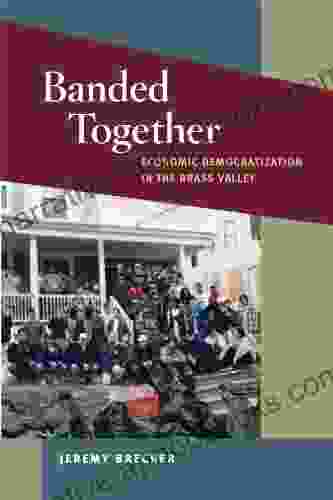Economic Democratization in the Brass Valley: Labor, Capital, and Community in American Industrial History

In the heart of the Naugatuck Valley of Connecticut, the Brass Valley emerged as a major center of brass production in the late 19th and early 20th centuries. This industrial region was home to a diverse workforce that played a crucial role in shaping the economic and social landscape of the United States. "Economic Democratization in the Brass Valley Working Class in American History" offers a comprehensive examination of the labor movements, industrial relations, and community dynamics that characterized this pivotal period in American industrial history.
The Rise of the Brass Industry
The development of the brass industry in the Naugatuck Valley was driven by a combination of factors, including the availability of natural resources, skilled labor, and access to transportation. The region's abundant waterpower and hydropower resources provided the energy necessary to power the machinery used in brass production. Additionally, the local workforce possessed a high level of technical expertise, honed through generations of experience in metalworking and manufacturing.
5 out of 5
| Language | : | English |
| File size | : | 961 KB |
| Text-to-Speech | : | Enabled |
| Screen Reader | : | Supported |
| Enhanced typesetting | : | Enabled |
| Word Wise | : | Enabled |
| Print length | : | 277 pages |
| Hardcover | : | 226 pages |
| Item Weight | : | 12.7 ounces |
| Dimensions | : | 6.14 x 0.56 x 9.21 inches |
| X-Ray for textbooks | : | Enabled |
The growth of the brass industry led to the establishment of numerous factories and mills in the valley, attracting workers from across the United States and Europe. These workers brought with them a diversity of skills, languages, and cultures, contributing to the region's vibrant and cosmopolitan atmosphere.
Labor Movements and Industrial Relations
As the brass industry expanded, so too did the labor movement. Workers in the Brass Valley organized and joined unions to fight for better wages, working conditions, and a voice in the workplace. The most prominent union in the valley was the Amalgamated Brass Workers of America, which represented thousands of skilled and unskilled workers in the industry.
The unions played a significant role in shaping industrial relations in the Brass Valley. They negotiated collective bargaining agreements with employers, established grievance procedures, and provided a platform for workers to advocate for their interests. While strikes and labor disputes were not uncommon, the unions generally pursued a strategy of cooperation and negotiation with management.
Economic Democratization
One of the most striking features of the Brass Valley working class was its commitment to economic democratization. Workers in the valley sought not only to improve their own wages and working conditions but also to empower themselves economically and politically. This commitment was reflected in the establishment of worker-owned cooperatives, credit unions, and mutual aid societies.
The Arbeiter Zeitung ("Workers' Newspaper"),a German-language newspaper published in the valley, played a pivotal role in promoting economic democratization. The newspaper espoused socialist principles and advocated for workers' rights and economic self-reliance. It also provided a platform for workers to share their experiences and ideas, fostering a sense of community and collective action.
Community Dynamics
The Brass Valley working class was not simply a collection of workers; it was a cohesive community with its own social and cultural institutions. Workers lived in close-knit neighborhoods, attended the same churches and schools, and participated in a variety of social organizations and activities.
The community was characterized by a strong sense of solidarity and mutual support. Workers helped each other in times of need, provided financial assistance to those who had fallen on hard times, and organized social events that brought the community together.
The immigrants who flocked to the Brass Valley brought with them their own cultural traditions and practices, which they shared with their American-born neighbors. This cultural exchange enriched the community and fostered a spirit of tolerance and understanding.
"Economic Democratization in the Brass Valley Working Class in American History" provides a fascinating glimpse into the lives and struggles of the workers who built the American brass industry. Through its exploration of labor movements, industrial relations, and community dynamics, the book sheds light on the complex and multifaceted nature of the American working class experience. It offers valuable insights into the history of labor, capitalism, and the pursuit of economic empowerment in the United States.
With its engaging narrative, rich archival research, and vivid illustrations, "Economic Democratization in the Brass Valley Working Class in American History" is an essential read for anyone interested in American history, labor studies, and the history of industrialization.
5 out of 5
| Language | : | English |
| File size | : | 961 KB |
| Text-to-Speech | : | Enabled |
| Screen Reader | : | Supported |
| Enhanced typesetting | : | Enabled |
| Word Wise | : | Enabled |
| Print length | : | 277 pages |
| Hardcover | : | 226 pages |
| Item Weight | : | 12.7 ounces |
| Dimensions | : | 6.14 x 0.56 x 9.21 inches |
| X-Ray for textbooks | : | Enabled |
Do you want to contribute by writing guest posts on this blog?
Please contact us and send us a resume of previous articles that you have written.
 Book
Book Novel
Novel Page
Page Chapter
Chapter Text
Text Story
Story Genre
Genre Reader
Reader Library
Library Paperback
Paperback E-book
E-book Magazine
Magazine Newspaper
Newspaper Paragraph
Paragraph Sentence
Sentence Bookmark
Bookmark Shelf
Shelf Glossary
Glossary Bibliography
Bibliography Foreword
Foreword Preface
Preface Synopsis
Synopsis Annotation
Annotation Footnote
Footnote Manuscript
Manuscript Scroll
Scroll Codex
Codex Tome
Tome Bestseller
Bestseller Classics
Classics Library card
Library card Narrative
Narrative Biography
Biography Autobiography
Autobiography Memoir
Memoir Reference
Reference Encyclopedia
Encyclopedia Lavanya Sharma
Lavanya Sharma Nitzan Shoshan
Nitzan Shoshan Tommy J Curry
Tommy J Curry Virginia Buckingham
Virginia Buckingham Bella Gonshorovitz
Bella Gonshorovitz Allison M Boot
Allison M Boot Jim Schmalzried
Jim Schmalzried Mickey Hess
Mickey Hess Michael Malek Najjar
Michael Malek Najjar Deborah Hopkinson
Deborah Hopkinson Jesse Graves
Jesse Graves Cyril Cunningham
Cyril Cunningham David Son
David Son Allie Burton
Allie Burton Paul Oakes
Paul Oakes Ronald L Greer
Ronald L Greer Madeline Puckette
Madeline Puckette Meta Washington
Meta Washington Allison Adair
Allison Adair Jacqueline Ruiz
Jacqueline Ruiz
Light bulbAdvertise smarter! Our strategic ad space ensures maximum exposure. Reserve your spot today!

 Dillon HayesPolitical Thriller Boston Brahmin: A Gripping Tale of Power, Betrayal, and...
Dillon HayesPolitical Thriller Boston Brahmin: A Gripping Tale of Power, Betrayal, and... Isaac BellFollow ·18.2k
Isaac BellFollow ·18.2k E.E. CummingsFollow ·16.5k
E.E. CummingsFollow ·16.5k Sidney CoxFollow ·7k
Sidney CoxFollow ·7k Edward ReedFollow ·18.9k
Edward ReedFollow ·18.9k Jack LondonFollow ·2.8k
Jack LondonFollow ·2.8k Tim ReedFollow ·13.9k
Tim ReedFollow ·13.9k Kevin TurnerFollow ·18.6k
Kevin TurnerFollow ·18.6k Eliot FosterFollow ·3.1k
Eliot FosterFollow ·3.1k

 F. Scott Fitzgerald
F. Scott FitzgeraldUnravel the Enigmatic Murder of Mary Russell: A...
Prologue: A Grisly Discovery In the...

 Connor Mitchell
Connor MitchellLittle Quilts: Gifts from Jelly Roll Scraps
Embrace the Art...

 Harold Powell
Harold PowellPoverty Survival Hope In An American City: A Pulitzer...
A testament to the resilience of the human...

 Ray Blair
Ray BlairConfronting Global Warming: Population, Resources, and...
Global warming is one of the most pressing...

 Gary Cox
Gary CoxStyle Your Most Authentic Self and Cultivate a Mindful...
Unlock Your True...

 Caleb Long
Caleb LongEmbark on a Colorful Patchwork Adventure: Discover 20 To...
Step into the captivating world of...
5 out of 5
| Language | : | English |
| File size | : | 961 KB |
| Text-to-Speech | : | Enabled |
| Screen Reader | : | Supported |
| Enhanced typesetting | : | Enabled |
| Word Wise | : | Enabled |
| Print length | : | 277 pages |
| Hardcover | : | 226 pages |
| Item Weight | : | 12.7 ounces |
| Dimensions | : | 6.14 x 0.56 x 9.21 inches |
| X-Ray for textbooks | : | Enabled |










